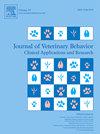利用灵芝检测榆树的木材腐朽--利用训练有素的狗进行的试点研究
IF 1.3
3区 农林科学
Q4 BEHAVIORAL SCIENCES
Journal of Veterinary Behavior-clinical Applications and Research
Pub Date : 2024-09-11
DOI:10.1016/j.jveb.2024.09.002
引用次数: 0
摘要
生物检测犬的使用越来越多,但缺乏系统的认证和验证方法。在这项试点研究中,我们使用 ANSI/ASB 标准 088(2020)来评估经过训练的狗的性能,以检测榆树中由寄生真菌灵芝引起的木材腐朽。在控制测试之后,又进行了实地研究,让狗对两个城市的榆树进行检测。通过声波断层扫描和目视检查,对狗指出的榆树健康状况和一些没有指出健康状况的树木进行了跟踪。试验结果表明,警犬在受控测试期间的表现与实地研究期间的表现相似:受控测试期间的总体灵敏度为 91%,实地研究期间的阳性预测值 (PPV) 为 81%。狗能在一小时内评估 30-60 棵树,而声波断层扫描每棵树至少需要一小时。将受过检测 G. adspersum 训练的生物检测犬与日常树木检查相结合,有助于比树木检查员更早地发现病原体,并有效地集中资源。本文章由计算机程序翻译,如有差异,请以英文原文为准。
Detection of wood-decay by Ganoderma adspersum in elm trees – A pilot study using a trained dog
The use of biodetection dogs is increasing but systematic approaches to their certification and validation are lacking. In this pilot study, the ANSI/ASB standard 088 (2020) was used to assess the performance of a dog trained to detect wood-decay caused by the parasitic fungus Ganoderma adspersum in elm trees. Controlled tests were followed up with a field study where the dog examined elms in two cities. The health of the elms indicated by the dog and a number of trees that were not indicated were followed up by sonic tomography and visual inspection. The pilot showed that the dogs performance during the controlled testing was similar to the performance during the field study: an overall sensitivity of 91% during the controlled tests and a positive predictive value (PPV) of 81% during the field study. Where the dog was able to assess 30–60 trees in an hour, sonic tomography takes at least an hour per tree. Combining a biodetection dog trained to detect G. adspersum into routine tree inspections can help to identify the pathogen earlier than tree inspectors can and focus resources efficiently.
求助全文
通过发布文献求助,成功后即可免费获取论文全文。
去求助
来源期刊
CiteScore
3.50
自引率
16.70%
发文量
107
审稿时长
325 days
期刊介绍:
Journal of Veterinary Behavior: Clinical Applications and Research is an international journal that focuses on all aspects of veterinary behavioral medicine, with a particular emphasis on clinical applications and research. Articles cover such topics as basic research involving normal signaling or social behaviors, welfare and/or housing issues, molecular or quantitative genetics, and applied behavioral issues (eg, working dogs) that may have implications for clinical interest or assessment.
JVEB is the official journal of the Australian Veterinary Behaviour Interest Group, the British Veterinary Behaviour Association, Gesellschaft fr Tierverhaltensmedizin und Therapie, the International Working Dog Breeding Association, the Pet Professional Guild, the Association Veterinaire Suisse pour la Medecine Comportementale, and The American Veterinary Society of Animal Behavior.

 求助内容:
求助内容: 应助结果提醒方式:
应助结果提醒方式:


